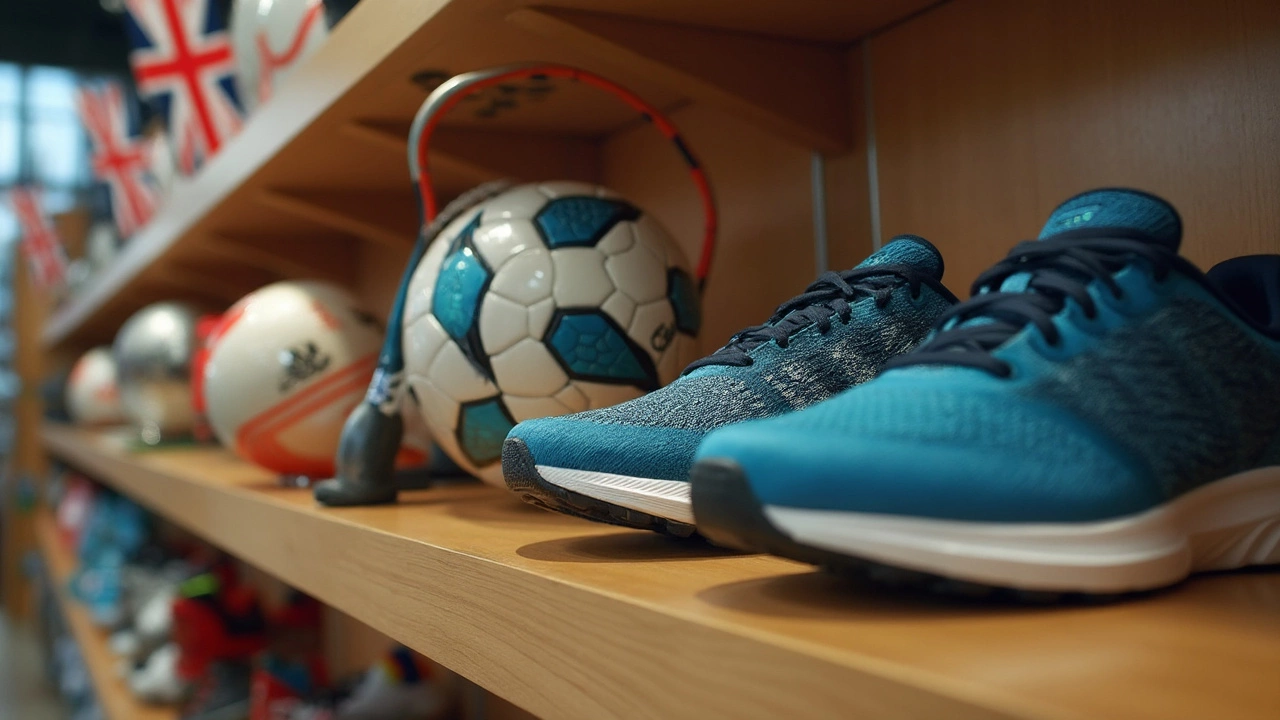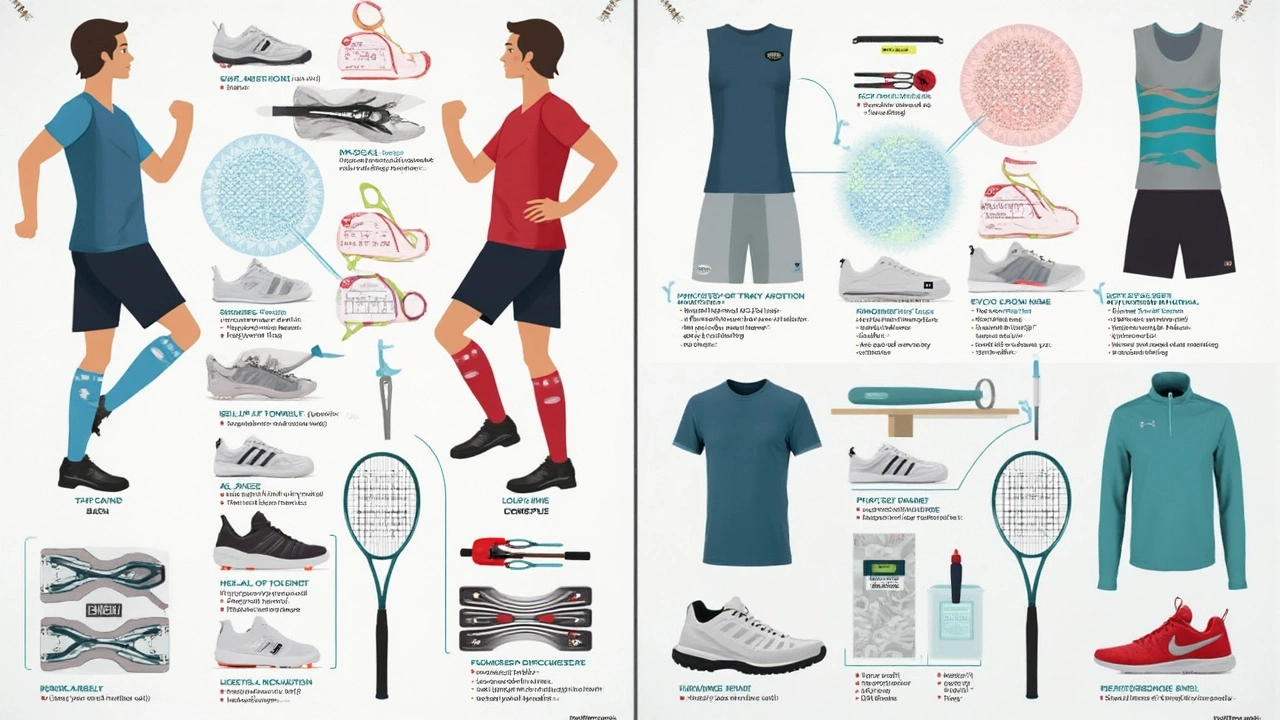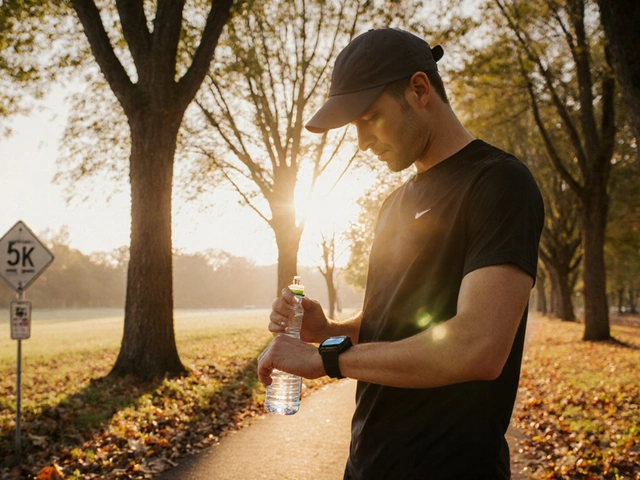Equipment Characteristics in Sports: What Really Matters

Why does some sports gear last for years, while other stuff falls apart after a few practices? It's usually all about the equipment's key characteristics. These are the things that decide if a piece of gear feels good, holds up through rough use, and actually helps your game. Just picking the most expensive ball or the coolest-looking helmet doesn't guarantee you’re making the right choice.
The most basic thing to check? What it’s made of. The materials control just about everything: how long something lasts, how heavy it feels, and even if it protects you well. There’s a reason pro cyclists use carbon fiber frames and not steel—the weight difference is huge. You'll notice similar trends with tennis racquets, hockey sticks, or even soccer cleats, where the material mix is probably pretty different from what you’d find in the 90s.
But there’s more to consider than just what factory churned out your glove or ball. Things like comfort, fit, and safety are all at stake. Bad shoes can mess up your knees, and a poor grip could cost you the match. So it's worth learning what really matters next time you shop for gear or want to upgrade your setup.
- Why Material Matters
- Look for Good Fit and Comfort
- Durability and Longevity
- Safety Features You Can't Skip
- Performance: How Equipment Changes the Game
Why Material Matters
Grab two basketballs—one made of genuine leather, the other of cheap rubber. Even if you've never played a game in your life, you'll notice the difference. Material isn’t just a technical detail; it shapes your whole experience with sports equipment.
Let’s talk about durability first. For example, carbon fiber frames changed cycling—lighter and stiffer than aluminum, they make climbing hills way less of a grind. In soccer, top-level boots switched from thick leather to synthetic blends. The result? Shoes are now lighter, dry faster, and last longer, especially in wet conditions.
Here’s a quick look at how material choices play out in real gear:
| Sport | Old-School Material | Modern Material | Difference |
|---|---|---|---|
| Baseball Bats | Wood | Aluminum/Composite | Lighter swing, more power |
| Tennis Racquets | Wood | Graphite/Carbon Fiber | Bigger sweet spot, less vibration |
| Bike Frames | Steel | Carbon Fiber | Lighter, customizable flex |
Weight matters, too. No one wants to run with heavy shoes or swing a bat that feels like a club. Advanced materials shave down ounces without losing strength. For instance, modern lightweight running shoes let marathoners keep their pace up across dozens of miles.
Athletes aren’t the only ones who benefit—material affects safety. Helmets used to be simple foam, but now they use advanced polymers or even gel layers to absorb more impact. The NFL reported a noticeable drop in concussion rates after using new helmet tech with better materials.
- Always check which materials a piece of gear uses before you buy—it can mean the difference between having it for one season or five.
- Look for labels or product info that mention why a certain material is used (for example, moisture-wicking, anti-microbial, or reinforced stitching).
Bottom line: better materials mean better performance, longer life, and safer play. It’s worth paying attention to those labels and product descriptions instead of just picking what’s cheapest or flashiest.
Look for Good Fit and Comfort
If you've ever tried playing soccer in shoes that pinch or used a helmet that wobbles on your head, you know how quickly comfort can make or break your experience. The right fit doesn’t just feel better—it can prevent injuries and boost your performance. No wonder most coaches and trainers swear by finding gear that fits your body and how you move.
Take running shoes, for example. Studies from sports science labs confirm that even a half-size off can raise your risk of blisters or even stress injuries over time. When it comes to helmets, a snug fit can be the difference between a minor knock and a serious head injury. Comfort focuses on the details: the cushioning in the sole, the ventilation in gloves, or how adjustable the straps on your pads are.
Here are a few simple tips to help you check for good comfort and fit the next time you’re shopping for sports equipment:
- Always try before you buy—walk, move, stretch, or swing to see how the equipment handles real action.
- Look for adjustable features (laces, straps, padding) so you can fine-tune for your body.
- Check for pressure points after a few minutes of use. Any discomfort will get worse when you’re playing.
- When ordering online, use the measuring guides. Every brand’s sizing may be a bit different.
Comfort might look like a small detail but it shows up big time on game day. If your gear feels like an extension of your body, you’ll play better and keep your focus where it belongs—on the action, not your aching feet or sore shoulders.

Durability and Longevity
Ever had a soccer ball split after a couple of games? Or a tennis racket frame that warps halfway through a season? Durability is a hallmark of solid sports equipment. It’s not just about lasting longer—it’s about staying safe and reliable as you train or compete. The gear you use should take a beating and keep going, especially if you’re using it several times a week.
What makes gear last? Materials are the first thing to look at. Many top-tier brands use reinforced plastics, composites, or treated leathers because they stand up to moisture, sweat, and rough handling. For example, football helmets use polycarbonate shells because they’re tough and don’t easily crack, even on hard impacts. Meanwhile, basketballs made from genuine leather will last years longer than rubber versions if you take care of them properly.
There’s also construction. Double stitching in gloves, seamless joints on bikes, and layered padding in shoes all play a role. Brands like Adidas or Wilson tend to tout features like “engineered lacing” or “integrated mesh overlays” for exactly this reason—they’re not just marketing terms; they actually help hold things together over time.
Here’s a clear look at typical lifespans for common equipment if you use and maintain them well:
| Equipment Type | Estimated Lifespan | What Impacts It |
|---|---|---|
| Soccer Ball (Synthetic) | 1-2 Seasons | Playing surface, storage, air pressure |
| Running Shoes | 300-500 Miles | Runner weight, terrain, shoe rotation |
| Tennis Racquet | 2-4 Years | String tension, frequency of restringing |
| Bicycle Helmet | 3-5 Years (sooner after a crash) | Sun exposure, impacts, heat |
If you want your gear to hold up, simple things help. Wipe down equipment to remove sweat, store items somewhere cool and dry, don’t leave balls in direct sunlight, and keep laces tied up and away from sharp surfaces. Replace parts like insoles or grips regularly—sometimes it’s a cheap fix that adds months to your gear’s life.
And don’t just trust the feel. Sometimes gear can look okay but lose its performance over time. For example, running shoes might still look good even after the foam loses its shock-absorbing power. A good rule: check for changes in performance, not just looks.
Safety Features You Can't Skip
If there’s one thing you shouldn’t mess around with when buying sports equipment, it’s safety. A lot of injuries have nothing to do with clumsiness or bad luck—they usually happen because the right safety gear wasn’t there, or it wasn’t doing its job.
Take helmets, for example. It’s not just about slapping anything on your head; the foam padding, shell construction, and even the chin straps are engineered for a reason. The Consumer Product Safety Commission found that helmets reduce the risk of serious head injury by up to 85% in bike crashes. That’s not a number you want to ignore.
Let’s break down a couple of must-have safety features you should always check before buying:
- Certification Labels: Look for official marks like ASTM or CE on helmets and pads. These mean the gear was tested and passed basic safety standards.
- Padded Impact Zones: Things like shin guards, gloves, and helmets all need proper padding at the spots where hits are most likely.
- Secure Straps and Closures: Loose gear is actually dangerous. Straps on helmets, gloves, and pads should fit snugly and not loosen during play.
- Breathability: Sounds odd, but proper airflow in pads or headgear helps keep you cool and avoid heat-related issues.
"Good equipment doesn’t just help you play better—it keeps the game safe for everyone on the field." — Sports Safety Foundation
Padding matters in more than one way—too much can lower your movement, but too little means you’re basically unprotected. The trick is to find gear that hits the sweet spot. In football, most pro-level helmets now use multi-layered systems that absorb both direct hits and the nasty spinning collisions that can cause concussions.
Now, check out some quick numbers that show why good safety gear matters, especially in youth sports:
| Sport | Common Injury | Injury Reduction When Proper Gear Used |
|---|---|---|
| Cycling | Head Injuries | Up to 85% |
| Soccer | Shin Injuries | Approx. 70% |
| Baseball | Face Injuries | Over 80% |
Bottom line: Don’t scrimp on safety. If the gear feels cheap, skips essential protection, or lacks certification, move on. Your future self will thank you.

Performance: How Equipment Changes the Game
If you think all sports balls, bats, or shoes are made equal, think again. The type and quality of sports equipment you use can actually make or break your game. For some sports, switching to better gear can seriously cut down reaction time, boost speed, or give you that little edge that wins the match.
Look at tennis as an example. Research from the International Tennis Federation showed players were able to hit serves up to 5 miles per hour faster by using newer carbon fiber racquets compared to old wooden models. That’s enough to turn an average serve into something seriously tough to return.
Or check out soccer cleats. A study out of the University of Duisburg found players wearing lightweight cleats ran the 30-meter dash a full 0.1 seconds faster than those in heavier, old-school models. Small changes, but at elite levels, it can mean the difference between scoring and missing.
- Basketball shoes with more ankle support reduce injury risk and improve jump height.
- Modern golf clubs with adjustable lofts make hitting longer or higher shots way easier for amateurs and pros.
- Hockey sticks now use composite blends that make slap shots fly faster while reducing player fatigue.
Check out some real-world data that shows just how much equipment upgrades can change key stats:
| Sport | Old Gear | Modern Gear | Performance Boost |
|---|---|---|---|
| Tennis (Serve speed) | 90 mph (Wood racquet) | 105 mph (Carbon racquet) | +15 mph |
| Soccer (30m dash) | 4.20 sec (Heavy cleats) | 4.10 sec (Light cleats) | -0.10 sec |
| Golf (Max shot distance) | 240 yards (Steel clubs) | 270 yards (Modern clubs) | +30 yards |
So if you’re serious about improving, don’t just blame your technique when things go wrong. Sometimes, updating your gear is exactly what your performance needs. Pay attention to how new models change weight, grip, or balance. Even weekend players can quickly feel the difference, especially in how much easier the game starts to feel.




